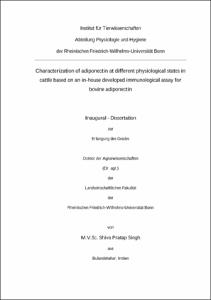Singh, Shiva Pratap: Characterization of adiponectin at different physiological states in cattle based on an in-house developed immunological assay for bovine adiponectin. - Bonn, 2014. - Dissertation, Rheinische Friedrich-Wilhelms-Universität Bonn.
Online-Ausgabe in bonndoc: https://nbn-resolving.org/urn:nbn:de:hbz:5n-34906
Online-Ausgabe in bonndoc: https://nbn-resolving.org/urn:nbn:de:hbz:5n-34906
@phdthesis{handle:20.500.11811/5827,
urn: https://nbn-resolving.org/urn:nbn:de:hbz:5n-34906,
author = {{Shiva Pratap Singh}},
title = {Characterization of adiponectin at different physiological states in cattle based on an in-house developed immunological assay for bovine adiponectin},
school = {Rheinische Friedrich-Wilhelms-Universität Bonn},
year = 2014,
month = feb,
note = {Adipose tissue (AT), through secretion of adipokines, plays a central role in regulating metabolism. Adiponectin is one of the most abundant adipokines and is linked with several physiological mechanisms such as insulin sensitivity and inflammation. The aim of this dissertation was to characterize the effect of stage of lactation and of supplementation with conjugated linoleic acids (CLA) on blood adiponectin in dairy cows. In addition, adiponectin concentrations in different AT depots and the effect of lactational and dietary induced negative energy balance (NEB) on blood and milk adiponectin were studied in dairy cows. Adiponectin concentrations of blood were studied using serum samples obtained from multiparous (MP) and primiparous (PP) cows receiving either CLA or a control fat supplement from d -21 to d 252 relative to calving, and serum as well as AT samples [3 subcutaneous (sc): tail-head, sternum and withers and 3 visceral (vc): mesenterial, omental and retroperitoneal] from PP cows slaughtered at d 1, 42 and 105 of lactation. Effects of lactational and dietary induced NEB on plasma adiponectin were investigated in MP cows from d -21 to d 182 relative to calving with feed restriction for 3 weeks beginning at around 100 days of lactation. Blood adiponectin was decreased from d 21 ante partum, reached a nadir at calving and increased during the post partum period. CLA supplementation reduced circulating adiponectin post partum in both MP and PP cows and, as indicated by a surrogate marker of insulin sensitivity (RQUICKI) also resulted in decreased insulin sensitivity. The decline in blood adiponectin around parturition may result from reduced adiponectin protein expression in all fat depots. vcAT contained more adiponectin than scAT suggesting a relatively higher impact of vcAT on adiponectin blood concentrations. However, retroperitoneal AT had the lowest adiponectin content compared to the other fat depots and thus seems to play an unique role in lipid mobilization in dairy cows. NEB due to feed restriction about 100 days of lactation caused a decline in adiponectin secretion through milk but did not affect its plasma concentrations. In conclusion, the major changes in blood adiponectin occurred around parturition; dietary CLA supplementation reduced circulating adiponectin. Differing amounts of adiponectin per AT depot indicate differential contributions to circulating adiponectin. The present dissertation serves as a basis for further studies elucidating the role and regulation of adiponectin and other adipokines in various pathophysiological conditions in cattle.},
url = {https://hdl.handle.net/20.500.11811/5827}
}
urn: https://nbn-resolving.org/urn:nbn:de:hbz:5n-34906,
author = {{Shiva Pratap Singh}},
title = {Characterization of adiponectin at different physiological states in cattle based on an in-house developed immunological assay for bovine adiponectin},
school = {Rheinische Friedrich-Wilhelms-Universität Bonn},
year = 2014,
month = feb,
note = {Adipose tissue (AT), through secretion of adipokines, plays a central role in regulating metabolism. Adiponectin is one of the most abundant adipokines and is linked with several physiological mechanisms such as insulin sensitivity and inflammation. The aim of this dissertation was to characterize the effect of stage of lactation and of supplementation with conjugated linoleic acids (CLA) on blood adiponectin in dairy cows. In addition, adiponectin concentrations in different AT depots and the effect of lactational and dietary induced negative energy balance (NEB) on blood and milk adiponectin were studied in dairy cows. Adiponectin concentrations of blood were studied using serum samples obtained from multiparous (MP) and primiparous (PP) cows receiving either CLA or a control fat supplement from d -21 to d 252 relative to calving, and serum as well as AT samples [3 subcutaneous (sc): tail-head, sternum and withers and 3 visceral (vc): mesenterial, omental and retroperitoneal] from PP cows slaughtered at d 1, 42 and 105 of lactation. Effects of lactational and dietary induced NEB on plasma adiponectin were investigated in MP cows from d -21 to d 182 relative to calving with feed restriction for 3 weeks beginning at around 100 days of lactation. Blood adiponectin was decreased from d 21 ante partum, reached a nadir at calving and increased during the post partum period. CLA supplementation reduced circulating adiponectin post partum in both MP and PP cows and, as indicated by a surrogate marker of insulin sensitivity (RQUICKI) also resulted in decreased insulin sensitivity. The decline in blood adiponectin around parturition may result from reduced adiponectin protein expression in all fat depots. vcAT contained more adiponectin than scAT suggesting a relatively higher impact of vcAT on adiponectin blood concentrations. However, retroperitoneal AT had the lowest adiponectin content compared to the other fat depots and thus seems to play an unique role in lipid mobilization in dairy cows. NEB due to feed restriction about 100 days of lactation caused a decline in adiponectin secretion through milk but did not affect its plasma concentrations. In conclusion, the major changes in blood adiponectin occurred around parturition; dietary CLA supplementation reduced circulating adiponectin. Differing amounts of adiponectin per AT depot indicate differential contributions to circulating adiponectin. The present dissertation serves as a basis for further studies elucidating the role and regulation of adiponectin and other adipokines in various pathophysiological conditions in cattle.},
url = {https://hdl.handle.net/20.500.11811/5827}
}






